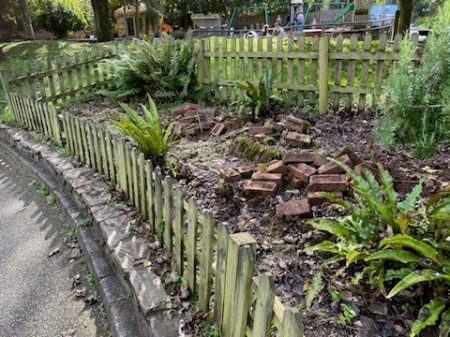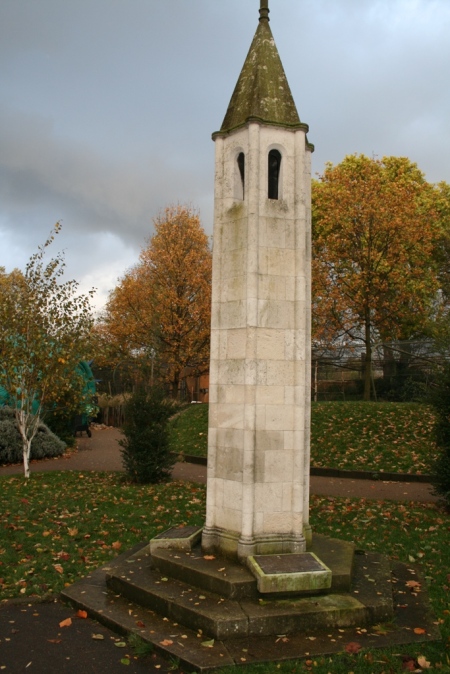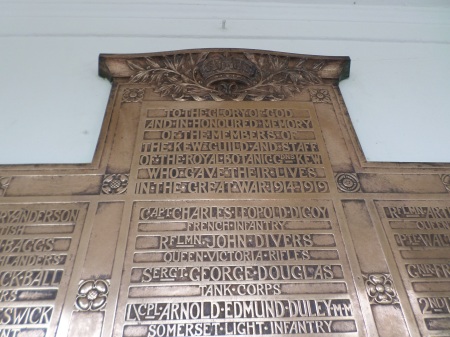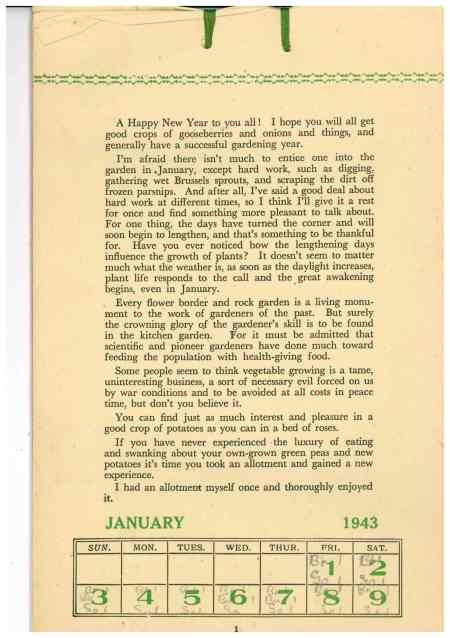Remembering Major Reginald Thomas Ball-Acton, killed in action in Ypres on May 22 1916.

Charles Annesley Ball-Acton (from Kilmacurragh website)
With the outbreak of the Great War in August 1914, Charles Annesley Ball-Acton, heir to the Kilmacurragh estate in Ireland and many of his gardens staff headed for the battlefields of France and Flanders.
On September 25th 1915, Charles Acton, while trying to assist a fellow soldier, was mortally wounded by an explosion at Loos. He was only 39.

Reginald Thomas Ball-Acton (from the Kilmacurragh website)
Kilmacurragh estate house and gardens in Ireland then passed to Charles’ only surviving brother, Major Reginald Thomas Ball-Acton, who was father of the late Charles Acton (a well known music critic for the Irish Times).
On May 22nd 1916, just eight months after his brother’s death at Loos, Reginald Ball Acton was killed in action in Ypres.
Few others of the Kilmacurragh gardeners came home from the war.
In eight years from 1908 to 1916, Kilmacurragh had three consecutive owners inflicting death duties amounting to 120% of the value of the estate. This placed enormous financial pressures on the family and, after two centuries, the Actons left Kilmacurragh House.
Kilmacurragh can be described as the Irish ‘Heligan’ gardens.
Before the war eleven men and two boys maintained the grounds. Following the deaths of Charles and Reginald, the gardens were maintained single-handedly by the old Head Gardener. Kilmacurragh for me neatly symbolises the steady decline of the old Irish estates from death duties and also from the unrest of the Irish Civil War.
Last month we posted a blogpost about horticulturalist Allan Livingstone Ramsay, one of the first British officers to due during the Easter Rising in April 1916.
https://worldwarzoogardener1939.wordpress.com/2016/04/24/alan-livingstone-ramsay-died-easter-rising-24-april-1916/
“Problematic”, that’s what I’d been told, “not something that could be so easily done in Ireland.” I’d been talking about commemorating The First World War and our World War Zoo Gardens project that uses history to engage visitors with plants at the Botanic Gardens Education Conference at Paignton Zoo in November 2014.
So what else happened in Ireland to zoo and botanic gardens staff during the First World War?
RZSI Dublin Zoo and the Great War
Seven L. Doyles are listed amongst the Commonwealth dead of the First World War.
Thankfully the Dublin Zoo staff member L. Doyle who joined up in 1914 is not (as far as records show) amongst these Canadians and Dublin Fusiliers of the same name. His employers, The Council of The Royal Zoological Society of Ireland RZSI / Dublin Zoo, generously kept his job open and paid his wife his wages in his absence. A patriotic gesture, and after all, it was popularly believed and expected that it would be a short war, all over by Christmas.
By Christmas 1914 with its famous football matches and spontaneous truce between the trenches, the RZSI Council which ran Dublin Zoo already had sorry cause to write with condolences and note in October 1914 the death in action of Lieutenant Victor Lentaigne, the 21 year old nephew of a long standing member of the Dublin Zoo Council, Joseph Nugent Lentaigne.
Victor Lentaigne
Lieutenant Victor Aloysius Lentaigne, 2nd Battalion, Connaught Rangers died on 14 September 1914 and has no known grave. From this early death date, he was probably involved in the Battle of the Aisne, as the fast flowing war of movement of the early months of the war rapidly stagnated and became entrenched. Lentaigne is commemorated amongst the 3739 names on the La Ferte-sous-Jouarre memorial to the missing British Expeditionary Force soldiers of the first three months of the war.
Reading through the rich detail in Catherine de Courcy’s excellent and well-illustrated history of Dublin Zoo, it is possible to see the deflected effect of war on Dublin Zoo.
Whilst they would have no staff war memorial like London Zoo or Belle Vue Zoo Manchester, there would be losses amongst the professional families, the wealthy patrons, the great and the good of the Anglo-Irish aristocracy who established and supported Dublin Zoo from its early 19th Century beginnings.
The great changes of the war years and immediate aftermath would see Dublin Zoo and its Council survive civil war, a war of independence and the establishment of an Irish Republic.

Helles Memorial to the missing of the Gallipoli campaign, Dardanelles, Turkey. (Image: CWGC website)
Frank Brendan O’ Carroll, Gallipoli 1915
The wealthy citizens and Dublin Zoo council members living in Merrion Square in Dublin had their own family losses, many of them amongst the young officer class.
One such was the son of Joseph O’Carroll MD FRCPI of 43 Merrion Square, Dublin. Second Lieutenant Frank Brendan O’Carroll, 6th Battalion, Royal Dublin Fusiliers died on 10 August 1915, aged 20 as part of the Gallipoli and Dardanelles campaign. He is remembered on panel 190-196 of the Helles memorial to the missing, Turkey.
The circumstances of O’Carroll’s death are recorded in the 6th Battalion war diary: http://www.dublin-fusiliers.com/battaliions/6-batt/war-diaries/1915-08/1915-08-trans-htm
7 August 1915 Suvla Bay. Made landing at C Beach on Anafarta Bay at 18.00. Battalion in reserve under Brig General Hill. Took up position at Entrance to Salt Lake. 6th and 7th Dublins attached to 31st Brigade.
8 August Suvla Bay. Battalion on water and ammunition fatigue for the Brigade
9 August 1915 Suvla Bay. Battalion attached to 33 Brigade (General Maxwell), Moved from beach about 02.30 to Hill 50. A Coy detached to support the right flank of the Brigade. Battalion ordered to support firing line near Ali Bay Chesme point 105-H-8.
Officers killed Lt Doyle, wounded believed killed 2nd Lt Stanton, 2nd Lt Mc Garry. Wounded and missing Major Jennings. Wounded Capt Luke, Capt Carrol, Lt Martin, 2nd Lt Carter, 2nd Lt Mortimer, 2nd Lt O’Carroll. Missing Lt Clery. Killed wounded and missing Other Ranks 259
The Europeana website has a poignant letter from father Joseph as he worries over four sons including another fighting in Gallipolli. http://www.europeana1914-1918.eu/en/contributions/3619
O’Carroll is pictured on www.irishmedals.org/gpage56.html
Mrs Barrington the manager of Dublin Zoo’s Houston House lost her husband in 19151916. There are several Barringtons listed as casualties in this period.
William Thornley Stoker Woods
In November 1916, the RZSI Council sent condolences to its Vice-President, later President, Robert H Woods, a neighbour of O’ Carroll, of 39 Merrion Square, Dublin whose son had died in action in France. Second Lieutenant William Thornley Stoker Woods, 62nd Brigade, Royal Field Artillery, died aged 20 on 27 October 1916. He is buried in grave IIE8 in the Guards Cemetery, Lesbouefs, Somme, France.

Arras Flying Services Memorial (Source: CWGC)
Thomas Pim
RZSI Council member Cecil Pim’s son Thomas died on 28 August 1918, serving as a Lieutenant in 13th Squadron, Royal Air Force (and previously the Royal Field Artillery). He is remembered on the Arras Flying Services Memorial to 1000 missing aircrew with no known grave on the Western Front.
Kilmacurragh Gardens the National Botanic Gardens of Ireland

These Ginkgo trees at Kilmacurragh are a strange war memorial (Kilmacurragh website)
The Acton family, their Gardeners and estate have a strange war memorial – a bed of interwoven Ginkgo trees and a spread of red rhododendron petals each year, like blood red poppies. Their story is well told on the Kilmacurragh website. http://www.botanicgardens.ie/kilmac/kilmhist.htm
There are other reminders of this wartime period at Kilmacurragh.
In the walled garden grow a line of mature maidenhair trees, Ginkgo biloba, planted just over a metre apart. Tradition has it that this was a nursery bed and since the garden staff believed that the war would last only a few weeks, the young trees were left in-situ with the belief that they would be placed in their permanent positions when staff returned that autumn. No one came home from those bloody battlefields and the maidenhair trees still grow in their nursery positions.
Glasnevin, Gallipoli and Charles Ball
C.F.Ball the assistant editor of Irish Gardening and senior staff at Glasnevin has an unusual memorial – an Escallonia C.F.Ball widely used in hedging. His story is told in the Kew WW1 section. He was killed at Gallipoli.
https://worldwarzoogardener1939.wordpress.com/2013/07/19/such-is-the-price-of-empire-the-lost-gardeners-of-kew-in-the-first-world-war/
Fota and Charlie Beswick
The story of Kew trained Irish son of the Head Gardener of Fota is also told in the Kew WW1 section, where he is remembered on the Kew staff war memorial. He was killed in 1917.
http://fotahouse.com/collections/charles-beswicks-school-atlas/
Posted by Mark Norris, World War Zoo Gardens project, Newquay Zoo.


 This Victorian ‘theme park’ or leisure gardens creation of Belle Vue Zoo closed in the mid 1970s.
This Victorian ‘theme park’ or leisure gardens creation of Belle Vue Zoo closed in the mid 1970s.










































